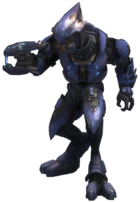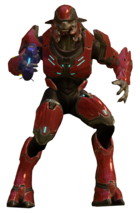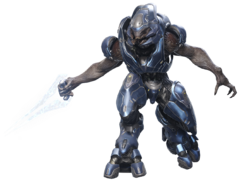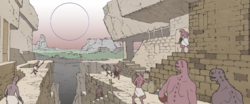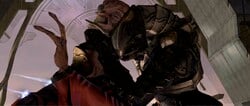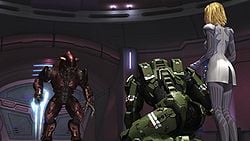Sangheili
From Halopedia, the Halo wiki
| Sangheili (Macto cognatus) | |
|---|---|
| Various Sangheili phenotypes. (not to scale) | |
| Physical information | |
|
Avg. height: |
|
|
Avg. weight: |
139 kilograms (310 lb) - 178 kilograms (390 lb)[1] |
|
Distinctions: |
Humanoid reptilian body structure; quadruple-hinged mandibles; binary circulatory system |
| Sociocultural information | |
|
Homeworld: |
|
|
Tier 2 | |
|
Notable individuals: |
|
|
Also known as: |
|
- "On the blood of our fathers, on the blood of our sons, we swore to uphold the Covenant!"
- — Rtas 'Vadumee before the raid on the Threshold gas mine.
The Sangheili[7] (Latin Macto cognatus,[8] meaning "I glorify my kin") are a saurian[9] species of fierce, proud, strong, agile and intelligent warriors. Named after their home planet, Sanghelios, they are known to humans as Elites[10] for their adeptness and skill in military strategy. The Sangheili formed the military backbone of the Covenant until just before the end of its existence. They had a very strong rivalry with the Jiralhanae, which finally led to open conflict during the Great Schism at the conclusion of the Human-Covenant War.
Originally a founding species of the unified conglomerate of races known as the Covenant, they later led the initial Covenant breakaway faction, the Fleet of Retribution, who sided with the humans against their former allies, due to the fact that the High Prophet of Truth and the High Prophet of Mercy had ordered the genocide of the entire Sangheili race. This was established after the assassination of the High Prophet of Regret at the hands of John-117. It was the Sangheili who were ultimately held responsible for the Prophet of Regret's death, and were seen as "unfit" to continue to guard the Prophets. The Prophets sought to achieve this through the use of the other Covenant races, primarily the Jiralhanae. The aftermath of the civil war formed the bedrock of the Covenant Empire's ultimate collapse and the end of the Human-Covenant War. However after the fragmentation of the Covenant, the Sangheili were still not at peace, as they would subsequently fight in an internal civil war and the Great Schism with the Jiralhanae would continue throughout the post Covenant war insurgency.
History
The Ark and reseeding
The Sangheili evolved in tropical wetlands of their homeworld, Sanghelios.[11] Sanghelios had at one point been visited by or had been in contact with the Forerunners. During the Forerunner-Flood war, the Librarian visited the planet to retrieve specimens of the Sangheili for preservation aboard Installation 00. After the firing of the Halo Array, they were returned to their home planet to begin rebuilding their culture.[12]
Development of civilization and the Covenant
After being returned to their homeworld, the Sangheili discovered artifacts left by the Forerunners on their planet. The Sangheili revered the objects these "gods" had left, and considered tampering with them a heresy beyond any other. However, some Sangheili scientists defied their species' dogma and studied Forerunner artifacts in secret; they would later become instrumental in helping the Sangheili reverse-engineer weapons against the San'Shyuum.[13] Several hundred years prior to the formation of the Covenant, the Sangheili had developed slipspace technology and created dozens of independent colonies, though their homeworld of Sanghelios remaining central to governance and culture. The planet of Creck, discovered before the Sangheili's contact with the San'Shyuum was the seventy-sixth of designated worlds explored by Sangheili. At some point, an unknown number of Sangheili clans waged war upon each other for numerous years on Sanghelios. These engagements became known as the Clan Battles of Sanghelios.[11]
In 938 BCE the Sangheili encountered the Reformist San'Shyuum, a race who also worshiped the Forerunners as gods, but had utilized Forerunner technology for their own needs, believing the technology had been left behind by the gods as gifts for their children.[14] This sparked a war between the two races over how to treat the relics. Even though the Sangheili were much more physically imposing and numerous, they suffered extreme casualties under the sheer power of the San'Shyuum's Dreadnought, a surviving Keyship, and by 876 BCE even the most devout had to admit their survival depended on the reconstitution of their own Forerunner technology. This led both sides to an agreement that ended with the decommissioning of the Forerunner Dreadnought and a shaky alliance that eventually expanded into the Covenant.
The San'Shyuum helped assuage the Sangheili by informing them of the Great Journey: by seeking out the Holy Rings scattered throughout the galaxy and utilizing them, a "Great Journey" would transform believers into godlike beings. The Writ of Union was drawn up in 852 BCE in order to codify the Covenant. Its first canto clearly outlines the nature of the Covenant from the perspective of the Prophets.
Being one of the few races in the Covenant to achieve space-faring status without outside intervention, Sangheili interaction with the San'Shyuum was initially strained due to memories of the recent war. Many Sangheili felt that the Writ of Union meant surrender to the San'Shyuum, although most never voiced these concerns.[15] The Sangheili Ussa 'Xellus led a major rebellion against the Covenant that was eventually neutralized with the rebel Ussans going into hiding.[16] Over time, the San'Shyuum and Sangheili formed a prosperous relationship, eventually laying the foundation for the modern Covenant hegemony.
During their membership in the Covenant, the Sangheili were simply put, technological and societal equals of the San'Shyuum. However, for a significant period, they found themselves as the dominant military muscle for the entire Covenant structure - hardly surprising given the warlike, feudal nature of their homeworld. What was surprising was the cyclical stability this feudal society was able to offer. Technological and medical advancement prospered, and the intelligent, aggressive Sangheili were peerless until they encountered the San'Shyuum. With exchange of goods and ideas, the Sangheili adapted to and eventually embraced the Covenant religion, grafting its tenets to their own belief system.[8]
Human-Covenant War
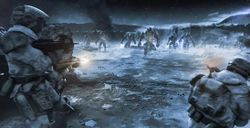
- Main article: Human-Covenant War
When the Prophets declared war on a previously unknown species called humans, the Sangheili followed their lead without question. After a period of time, however, even though the Prophets insisted that the humans were "unclean beings" that must be eliminated from the galaxy, some seasoned Sangheili veterans began to question the refusal of the Prophets to even consider accepting the humans into the Covenant. They seem to believe that humans, although physically weak, at least compared to themselves, are brave and even honorable. As such, these few Sangheili believed that humans should be offered admittance to the Covenant.[17] Some even believed that the humans are equal to them - a considerable step for a Sangheili, or any member of the Covenant to make. These Sangheili admired how willing and brave the humans were when fighting to survive against outright extinction, they even respected to a certain degree those few soldiers who were willing to stay behind and cover their comrades from a Covenant attack. A few Sangheili even had more respect for the humans than they did for the San'Shyuum before the Great Schism.
The Great Schism
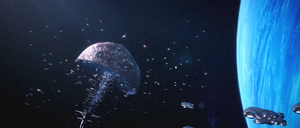
- Main article: Great Schism
During the final months of the Human-Covenant War, the political shift caused by the High Prophet of Truth and Tartarus, the Chieftain of the Jiralhanae, started a slippery slope that ended in the dissolution of the Covenant between the Sangheili and the San'Shyuum. Originally, the Jiralhanae were viewed as savagely aggressive and extremely goal-oriented, which the Sangheili viewed as a serious threat should the Brutes ever begin to desire political power. This fear became reality when the Honor Guards of the Prophets, originally an all-Sangheili class, were transformed into a duty of the Brutes. This was directly caused by the death of the High Prophet of Regret at the hands of John-117, the human "Demon", despite Regret's protection from his personal squad of Sangheili Honor Guardsmen. Soon the Jiralhanae found themselves in new positions of power, becoming veritable replacements for the Sangheili. During the concurrent Battle of Installation 05, Arbiter Thel 'Vadamee and Special Operations Commander Rtas 'Vadumee discovered the truth of the Halo rings from the Monitor 343 Guilty Spark; from this, they learned that the Prophets' promises of the Great Journey were false.
These events led the entire Sangheili species to secede from the Covenant,[18] forming a faction later to be known as the Swords of Sanghelios. They were aided by a few of the member races within the Covenant, such as many Unggoy and most Mgalekgolo, although many sided with the High Prophets despite the Sangheili's efforts. The secession included a movement to destroy the treacherous Jiralhanae and High Prophets, and the destruction of the Flood at all costs, eventually resulting in an alliance between the Arbiter's forces and humanity.
The Great Schism stretched from the human homeworld, Earth, all the way back to Sanghelios as the Sangheili attempted to wrest their share of the hegemony away from their new-found enemies. The Jiralhanae stepped in to fill the military void in ever increasing numbers, sensing the vacuum and opportunity left by the departure of the Sangheili.
Fall of the Covenant
After the Battle of Earth, the Sangheili and humans managed to stop and subsequently kill the Prophet of Truth, effectively dissolving the Covenant. However, the Sangheili and humans were coerced to deal with a more massive threat; the Flood. Finally, the Arbiter and the Master Chief, after activating the newly constructed replacement Halo ring, effectively ending the Flood threat.
Following the destruction of the Covenant, Sangheili society plunged into crisis. Already lacking centralized governance and splintered to independent city-states spread across several dozen major colonies,[19] they fractured into multiple infighting factions with varying ideas on how to run their society, despite their ongoing war with the Jiralhanae. This was largely due to the fact they had become reliant of the Prophets during the millennia of the Covenant's existence. As they regained their independence, they were forced to re-learn to manage their society on their own, without the direction of the Prophets or the manual labor provided by the other client races.[20] One faction, the Servants of the Abiding Truth, opposed Thel 'Vadam and his allies, specifically their rejection of the notion of the Forerunners being gods.[21]
As the Great Schism went on, the Sangheili continued their fight against the Jiralhanae. This was proving largely unsuccessful and the Sangheili were accepting serious losses. Without the Covenant to provide them with ships, technology, and repairs, they slowly lost warships and technologies they couldn't repair or replace. After the San'Shyuum went into hiding, the Sangheili began to prevail against the Jiralhanae, who in turn began to fight amongst themselves. Having abandoned the Covenant, the Sangheili were now in a state of mass confusion in regards to their religion, because even though the San'Shyuum lied to them, they had still given them purpose for their actions. Many Sangheili were still religiously devoted to the Forerunners and were attempting to uncover the meaning of their faith.[22]
Human involvement
After the Human-Covenant War, there was competition between the UNSC and the Sangheili, when it came to examining Forerunner ruins and relics like the Portal at Voi.[23] By March 2553, a tentative ceasefire continued to exist between humanity and the Sangheili. Although Arbiter Thel 'Vadam campaigned for peace between the two species across various Sangheili states, many Sangheili continued to view humans with suspicion, perceiving them as a threat and wanting to destroy them once and for all. At the same time, the UNSC's Office of Naval Intelligence took advantage of the unstable political situation, attempting to keep the Sangheili splintered and disorganized by inciting the Servants of the Abiding Truth, led by Avu Med 'Telcam, to rebel against 'Vadam. This was to make sure the Sangheili would not pose a threat to humanity again, in spite of the UNSC's alliance with the Arbiter's faction.[24]
ONI's aid allowed the Servants of the Abiding Truth to amass enough weapons to begin an all-out insurrection against 'Vadam and his allies in early 2553. Meanwhile, however, ONI's efforts also backfired; partially as a result of their actions the Sangheili Jul 'Mdama began a personal quest against humanity, forming a Sangheili-led reconstituted Covenant mainly from ex-Covenant forces. Four years after the battle at the Ark, this group launched an invasion on the Forerunner shield world Requiem, intending to find and awaken the Didact, a Forerunner Promethean they revered as a living god. Meanwhile many Sangheili resumed their feud with the hostile factions of Jiralhanae and thus the Sangheili were fighting in a two-front war.
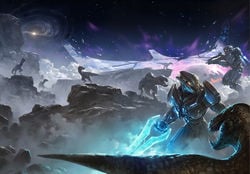
In spite of ONI's underhanded mission, relations between humanity and Sangheili at large continued to be amicable. For example, the UNSC and the Sangheili under the Arbiter maintained mixed control over certain space territories, known as Joint Occupation Zones. The UNSC and Swords of Sanghelios participated in joint operations, including the Mission to Installation 00, where they successfully prevented the reactivation of the Halo array and an attack on Earth. The UNSC Navy and the Sangheili also participated in joint naval operations, including one against pirates in 2557.[25] Human and Sangheili scholars also gathered and studied the Covenant's records together on Sanghelios.[26] Collaborative weapons research (such as the study of the physics behind the Type-33 Needler) and exchanges in military intelligence between the two species is also known to have taken place.[27] In addition, a select number of Sangheili are known to have been offered the opportunity to train alongside Spartan-IVs in War Games simulations as part of the ANVIL initiative.[28] A notable example of trust and technological exchange between humanity and Sangheili is the Helioskrill armor, a variant of MJOLNIR Powered Assault Armor, one of the most sophisticated pieces of human technology, which was designed by a Sangheili prodigy and manufactured by the Kolaar Manufactorum, a forge based on Sanghelios.[29] On the other hand, not all humans were amicable towards coexistence with the Sangheili, as seen with the Sapien Sunrise. In one notable incident, nine members from the aforementioned terrorist organization infiltrated Richard Sekibo's delegation at a peace summit on the colony world of Biko. They intended to assassinate Sekibo and a Sangheili delegation while framing the Sangheili of the crime. The assassination attempt was foiled by Spartan John-117 though Sekibo was mortally wounded. Unfortunately, the truth was covered up and John-117 was used as a scapegoat to hide the UEG's laxity towards preventing the attack, much to the frustration of the Sangheili delegation. Later John-117's name was cleared.
During the crisis that followed the dissolution of the Covenant, some Sangheili sought asylum on Earth. In 2558, at least one settlement of former-Covenant races was based in the South American city of Rio de Janeiro.[30]
In one notable incident, the Office of Naval Intelligence deployed three prowlers to trail the allied Sangheili assault carrier Shadow of Intent. All three stealth vessels were reported destroyed under unclear circumstances; the losses were not reported to UNSC Naval authorities.[25] Despite this, the alliance between the Arbiter and humanity continued to hold. On March 5, 2558, 'Vadam accepted the UNSC as mediators to oversee his peace negotiations with the Jiralhanae Chieftain Lydus. Though the negotiations were put on hold due to an attack by New Colonial Alliance mercenaries.[31]
On October 28, 2558 the Swords of Sanghelios emerged victorious over Jul 'Mdama's Covenant at the Battle of Sunaion. Sanghelios became a safe haven for surviving UNSC forces after the Created took control of Earth and most human colonies.[32]
Description
Sangheili are physically imposing beings, typically standing more than a foot taller than the average human. They are vaguely reptilian in overall appearance, with leathery skin, reverse-jointed legs and sharp claws and teeth. Their large hands have two fingers and two thumbs. Their most distinguishing trait is their jaw structure, which is made up of four separate mandibles attached to their face.
The Sangheili are known for great strength and intelligence, and are praised for their bravery and honor. Sangheili warriors augment these natural abilities further through use of energy shields integrated into their armor. Depending upon rank and mission objective, they are commonly seen in battle with plasma rifles, carbines, Needlers, needle rifles, and sometimes energy swords. Sangheili employ coffin-like orbital insertion pods as well as Spirit and Phantom dropships for military transit purposes and rapid-response operations.
Historically, Sangheili have followed the Covenant mentality of maintaining hatred towards humanity, believing them to be an affront to their religion and a challenge towards the Great Journey. However, many Sangheili were able to put this animosity aside when an alliance of Sangheili joined the UNSC during their expedition to the Ark. After the Human-Covenant War, many Sangheili are still distrustful of humanity and some still wage war against them. Nonetheless a large number of Sangheili, most notably those loyal to Thel 'Vadam, have attempted to form steady alliances with their former enemies.
Anatomy and physiology
Sangheili are muscular and very tall, usually standing between 2.25 and 2.62 meters.[1][2] Their jaws are quadruple-hinged, with an upper jaw and four lower mandibles arranged in two tiers. Mandible and upper jaw structure along with teeth shape and numbers result from different phenotypes; however they do not indicate reproductive isolation.[33] These mandibles have between six and twelve teeth each and some Sangheili have an additional, larger fang on the tips of each mandible.[34][35] Anywhere from eight to more than a dozen broader teeth may be mounted on the upper jaw structure. Adult Sangheili mandibles can be found in varying shapes, sizes, and ranges of dexterity, and are as distinctive as a human fingerprint.[36] Some Sangheili also possess molars. Sangheili smell with the use of two nostrils, each slightly in front of and below the eye socket. Given their predatory nature, a Sangheili's sense of smell is likely very developed.
Their hands are tetradactyl, each having two fingers in the middle and an opposing thumb on either side. Their legs are digitigrade, with short upper and lower legs, and elongated tarsals, using the distal and intermediate phalanges to support their weight when walking. This arrangement possibly allows them to run very quickly and jump large distances, compared to ordinary humans and other Covenant races.[37] Their superior agility may also be attributed to their homeworld's higher gravity; the additional strength required to move normally in a high-gravity environment would likely cause them to be more powerful in lower gravity situations (though, curiously, their tall, large, and lean figure would be extremely disadvantageous and impractical on a high-gravity planet—an arrangement possibly allowed by other major factors in their biology and life cycles; alternatively, the impressive strength and agility may be the result of the capabilities of their standard-issue combat harnesses). They also appear to have a double set of pectoral muscles, which contributes to their incredible strength. On the other hand, their digitigrade stance makes it difficult for them to climb vertical constructs such as ladders.[38]
Sangheili have a binary circulatory system[39][40] that pumps indigo-colored blood. They breathe oxygen and their homeworld has a nitrogen-oxygen atmosphere comparable to Earth's, allowing them to breathe the same atmosphere as humans. Sangheili cannot breathe molecular nitrogen.[41] Sangheili possess a cloaca, which is a common orifice for the digestive, reproductive and urinary tracts.[42]
Most Sangheili have leathery skin covered in many part by scales. Young Sangheili have pale protective scales hanging from their necks that they lose with age, an evolutionary leftover from the days when Sangheili parents used to carry their offspring in their jaws.[43] Sangheili skin color can range from light brown to dark brown and from light gray to black. They have forward-facing eyes with vertical slits and horizontal eyelids much like those of terrestrial reptiles,[44][45][note 1] likely giving them high-resolution central vision and depth perception. Sangheili are unable to perceive purple tones, which they see as blue. They are also able to see in the "infrabrown range". This apparently indicates that they lack L cone cells.[46] Their eyes can have multiple colours ranging from red all the way to green and can be even gray. Most Sangheili though possess yellow or orange eyes.[note 2][note 3]
Sangheili exhibit minor sexual dimorphism, with the females being slightly smaller than the males.[47] Sangheili males possess a subtle leathery scent, while females have been described as smelling like "clean feathers".[48] Sangheili are oviparous, meaning that they lay eggs rather than giving live birth.[49] They incubate their recently hatched young in tank-like pods.[50] The species is remarkably long-lived; Sangheili over 60 or 70 years of age have shown to be fully fit for combat duty,[51][52] and Jul 'Mdama was considered young, at least in keep elder terms,[53] at 64 years old.[54] Circa 100,000 BCE Sangheili life expectancy was 27 Earth years.[49][55]
Culture
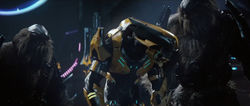
Although Sangheili are naturally very intelligent, their culture's long dependence on a military-industrial schema has led to an emphasis on might over science. In some regards, the advent of the Covenant made this position easier-allowing the Sangheili to concentrate even more monomanically on military endeavors, while Prophets took care of science and technology.[8] Despite this, their adeptness at using and creating technology is evident.
Raised from childhood to be warriors, other societal roles are treated as secondary endeavors or even hobbies. Doctors are considered outright dishonorable as they "spill blood" outside the battlefield;[56] despite this, the Sangheili are known to employ advanced medical technology[8] that is superior to humanity's.[57] Few doctors exist within Sangheili society. Instead, Huragok and other species are employed as medical personnel. Most injuries sustained by the Sangheili can easily be treated by the medical technology employed by the species, otherwise they accept their fate. However, Sangheili hold disdain for using medical technology to treat themselves and some personally would rather suffer through their injury or die. There is evidence of this being overturned, however.[58] Some Sangheili recognize that other species do not share the same views on medical treatment and were willing to lend them their medical technologies or even treat the wounded individual themselves.[59] Sangheili are trained to be skilled in most ranged weapons, as well as hand-to-hand combat. A prominent example of this martial focus is that only aristocrats are allowed to wield energy swords and that sword-wielders are then no longer eligible for marriage; however, they may breed with any female they choose, married or otherwise, to ensure successful transmission of "swordsman" genes. Many Sangheili children are trained in basic swordsmanship early on, both for personal development and for them to be capable of using a sword later in life if necessary. Within the military, an aristocratic title is not necessary for wielding an energy sword.[60]
Military promotion among the Sangheili is by merit. A Sangheili soldier must succeed to advance among the ranks, with this success being measured in combat kills. A Sangheili near the top of the military hierarchy may have personally slaughtered thousands of individuals to reach that status.[61] This practice sometimes puts individuals of questionable strategic acumen in positions of command. In the case of Ripa 'Moramee, a particularly brutish Sangheili was appointed as Arbiter, both for his martial ability and for his unquestioning obedience to the Prophets.
Historically the Sangheili have considered most other species to be inferior to them, both culturally and in fighting skill; this thinking has caused Sangheili to treat other species cruelly and in an arrogant manner. This eventually led to the feud between the Sangheili and Jiralhanae. In the years following the Great Schism the Sangheili entered a period of cultural renaissance however, triggering a rethinking towards their practices under the Covenant. This included views on medicine,[58] secularism (seen in the war between the theocratic Covenant and secular Swords of Sanghelios), gender roles,[62] and technology, and there was also evidence to suggest that views on other species underwent a gradual ongoing alteration too. It was noted that an Unggoy was able to take command of Sangheili and lead them in such a way so as to inspire respect and admiration from them.[63] This was unprecedented given the past observed relationship between the two species. The longstanding feud between the Sangheili and Jiralhanae was well documented, but in 2558 Thel 'Vadam engaged in talks with a Jiralhanae Chieftain known as Lydus on Ealen IV. Lydus accused Thel of engaging with the talks so that the Sangheili could simply acquire Jiralhanae resources, however Thel rebutted the notion with the idea that the Sangheili cared for more than just that.[64]
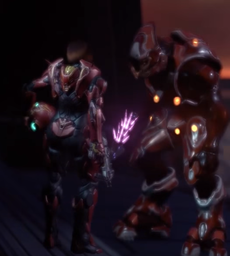
One great indicator of the Sangheili's evolving attitudes towards other species was their interactions with humans in the decade following the end of the Human-Covenant War. During and immediately after the conflict, most Sangheili typically espoused the Covenant's position towards humans as being heretics, and humans were subject to much of the same cultural arrogance from the Sangheili that the other species received; perhaps worse. By 2558 however the social landscape within the Swords of Sanghelios appeared drastically different with regards to humans. Specific examples include the development of a GEN-2 Mjolnir variant known as Helioskrill armor by a Sangheili weaponsmith,[65] training programs involving Spartan-IVs and Swords of Sanghelios troops in the ANVIL Initiative,[66] joint-operations between UNSC and Swords of Sanghelios in the joint-occupation zone against pirate raiders,[67] cooperative weapons and technology research and development (Such as with regards to the Needler[68] and the ANUBIS-class Mjolnir variant's enhanced sensors[69]) as well as other cooperative endeavors between the two powers (Archivist teams[70] and Zeta Halo containment efforts[71]). The obvious practical nature of much of these endeavors strongly implies that the Sangheili have come to view humans as a worthy investment, investor and ally, which is in stark contrast to their culture of 10 years past. Even in more remote locations on Sangheili colonies the culture appeared to be undergoing remarkable change. It was noted by Olympia Vale during her travel to Khael'mothka that she met many Sangheili who had become tired of the war and who were intrigued by the idea of a human staying with them. There were of course those who would try to harm Vale if they could, however she learned who to stay away from and for the most part found herself in no personal jeopardy.[72]
There were of course many who refused to change their ways, such as Jul' Mdama's Covenant, and this was highlighted by the Sangheili civil war. However as of the emergence of the Created, the Covenant appear to have been almost entirely wiped out by Swords of Sanghelios forces[73] implying that progressive factions in Sangheili society eventually won out.
Sense of honor
- "What madness Sangheili honor can be. They should be careful, lest they lose their way."
- — The Prophet of Regret[74]
The Sangheili display respect and admiration for honorable fighters, whether they are allies of the Sangheili or not; it is not unusual for the Sangheili to have such an admiration for their adversaries. Sangheili respect and revere veterans and often follow their lead. Their history is rife with victorious combatants welcoming the defeated enemies' remaining forces into their own army, provided of course that they fought with honor. During the Unggoy Rebellion, the most tenacious of the Unggoy who survived the conflict were admitted for the first time into previously all-Sangheili forces, much to the Prophets' discontent.[75]
Despite their intelligence, the Sangheili often allow their obsession with honor to cloud their better judgement. The Sangheili usually employ complex strategy only if it either improves success in battle, allows them to inflict more casualties on their enemies, or if it conforms to their code of honor. Otherwise, in both tactical and strategic combat, Sangheili generally charge their enemies with reckless aggression, regardless of any damage they sustain. Only very seldom do they admit temporary defeat, while lower-ranked Sangheili might make numerous tactical mistakes, such as standing in the open rather than taking cover. More experienced Sangheili are notorious for luring their enemies into traps and quickly dispatching them in close combat. Sangheili often sustain heavy casualties in the fervor to kill, though they use their client races to screen and protect themselves. The race's desire for grandeur has led to their defeat in many engagements, such as the Battle of Psi Serpentis, Operation: FIRST STRIKE, and the Battle of Onyx.
One of the clearest examples of how zealous the Sangheili are for honor comes from when Thel 'Vadamee engaged the UNSC during his time as Supreme Commander, when Thel and two Special Operations Sangheili attacked an unarmed 3rd Battalion Reserves during the assault on the planet Camber. When Thel saw the humans unable to defend themselves, he dropped his Type-25 plasma rifle and activated his active camouflage so the Marines could gear up and have a chance to fight. This was the first time the humans documented the Sangheili strive for honor, even if it endangered themselves or others.
Conversely, those who favor practicality over religious fervor in combat exhibit keen tactical and strategic acumen. The Zealots, despite being among the most fervent adherents of the Covenant's religion, use shrewd, pragmatic tactics and are willing to engage in subterfuge in lieu of open combat. Similarly, special operators and stealth specialists use active camouflage even in combat, though most would prefer to fight outright than to skulk in shadow. The separatist Fleet of Retribution destroyed the Prophet of Truth's fleet, despite the latter outnumbering the former three-to-one. Some Sangheili, such as Jul 'Mdama, see honor as more of an aspiration than a way of life and are willing to engage in deception if need be, particularly after seeing humans use such tactics to great effect.[76]
The Sangheili code of honor appears quite similar to Japanese Bushido, sharing concepts such as skill in combat (with an emphasis on swordsmanship), loyalty to master and family/clan, and views on death. Both systems promote death in battle as being the most honorable and proper way to die. If a warrior is critically injured, incapacitated, or captured, the only acceptable recourse is to commit ritualistic suicide, ensuring one's honor is kept intact. This is of such importance to Sangheili warriors that even if they are incapable of killing themselves, they may request the assistance of their fellow Sangheili in doing so.[77] The Sangheili consider being captured in combat to be dishonorable. To retain his honor, a valiant Sangheili would typically commit suicide while in prison. Often when imprisoned Sangheili are freed those who have not killed themselves are executed anyway, as was the case with one of Thel 'Vadam's ancestors. However, escaping or staging an uprising is acceptable, by the same example.[78]
Customs and superstitions
Despite their martial nature, the Sangheili have reservations to the spilling of one's own blood. This is an extension of the belief that the blood of a warrior is his essence, which is synonymous with his honor; thus, to spill one's blood is to lose one's honor.[56] As a result, in Sangheili culture, doctors are seen by many as the lowest members of society because they "..make [their] living slicing and causing another Sangheili to bleed without honor."[56] This means that the only 'honorable' way for a Sangheili to be injured or bleed out is from combat with the enemy. This belief also makes visiting a doctor very shameful for some Sangheili.
The Sangheili seldom view personal weapons as anything more than tools of war, and rarely attach extra importance to a weapon simply because it once belonged to a great warrior. This was especially true during the Covenant's days, when weapons were mass-produced and warriors did not carry customized weapons. However, certain historical weapons, such as the End of Night, were so famous that they were said to possess a small part of the owner's heart, and were given names as a result.[79]
Many Sangheili believe that a weapon is to be drawn only if it is to be used, because a drawn weapon "demands blood."[80] However, it appears that the user's intention when it is being drawn matters more than the weapon actually being used. For example, a Sangheili may draw his weapon when he is not sure if an incoming dropship contains friends or foes, only to deactivate it upon seeing friends exit the dropship.[81]
As a symbolic gesture of love for his people, a Sangheili leader may choose to walk among his followers and help them in their duties, even doing what is normally considered females' work such as helping them care for eggs. This is also done to inspire the Sangheili to work diligently so as to not be outdone by their superiors.[82]
Government
The Sangheili have no unified government; they are splintered into numerous feudal,[83] meritocratic states.[84] A given state is governed by a single clan residence and assembly house known as a keep, headed by a kaidon selected by a council of elders. There are usually a number of "client ke
- ^ a b c Halo: The Essential Visual Guide, page 61
- ^ a b Halo: Combat Evolved Anniversary, Library
- ^ Halo: Evolutions - Headhunters
- ^ Kilo-Five Trilogy
- ^ Halo 4, Spartan Ops
- ^ Hunt the Truth, Xenophobia
- ^ Halo: Ghosts of Onyx, page 189 ("Sangheili: the Elite name for their race")
- ^ a b c d Bestiarum
- ^ Bungie.net: Halo: Reach: Enemies - Elite
- ^ The Official Halo 2 Strategy Guide page 43
- ^ a b Halo: Broken Circle, Chapter 1
- ^ Halo Legends, Origins
- ^ Halo: Broken Circle, pages 62-63
- ^ Halo: Contact Harvest
- ^ Halo: Broken Circle, page 48
- ^ Halo: Broken Circle, pages 209-210
- ^ Conversations from the Universe
- ^ Canon Fodder "The resulting conflict would be called the Great Schism, and it would divide the Covenant into two, ultimately forcing the Sangheili out."
- ^ Eleventh Hour reports - Report 2
- ^ Halo: Glasslands, Chapter 2, page 53
- ^ Halo: Glasslands, Chapter 1, page 20
- ^ Halo: Evolutions, "The Return"
- ^ Halo: Evolutions - From the Office of Dr. William Arthur Iqbal
- ^ Halo: Glasslands, Chapter 1, page 66
- ^ a b Halo Waypoint: Catalog Interaction (post 2969315)
- ^ Halo Waypoint: Catalog Interaction (post 2969317)
- ^ Halo Waypoint: Catalog Interaction (post 2969311)
- ^ Halo Waypoint - Canon Fodder: 2-20-15
- ^ Halo 5: Guardians Multiplayer Beta, Helioskrill armor description
- ^ Spartan Ops S1E1 Departure
- ^ Halo: Escalation
- ^ Halo 5: Guardians, Guardians (level)
- ^ https://forums.halowaypoint.com/yaf_postsm2994218_Catalog-Interaction.aspx#post2994218
- ^ Halo Wars: Genesis, page 7
- ^ Halo Graphic Novel, page ??
- ^ Halo Waypoint: Sangheili
- ^ Halo: Contact Harvest, page 201
- ^ Halo: Contact Harvest, page 200
- ^ Halo: Ghosts of Onyx, page 226
- ^ Halo Encyclopedia, page ???
- '^ Halo: The Cole Protocol, page 200
- ^ Halo 2: Anniversary
- ^ Halo: Shadow of Intent, page 19 (Google Play edition)
- ^ Halo 4
- ^ 'Halo 2: Anniversary
- ^ Twitter: JoshingtonState (@JoshingtonState: "Little known fact, Elites are all color blind (like @franklez). This whole time they thought they were using BLUE! ;)") ("@JoshingtonState: "Frank says "infrabrown range" - not sure exactly what this means.")
- ^ Halo: The Thursday War, page 189
- ^ Halo: The Thursday War, page 208
- ^ a b Halo Waypoint - Query: Catalog
- ^ Halo: Blood Line, Issue 3: "Reff and I hatched on (sic) the city-state of 'Thasanee."
- ^ Halo 4: The Essential Visual Guide, page 29
- ^ Halo: The Essential Visual Guide, page 11
- ^ Halo: Glasslands, page 61
- ^ Halo 4: The Essential Visual Guide, page ??
- ^ Halo Waypoint: Catalog Interaction - Page 39
- ^ a b c Halo: The Cole Protocol, page 143
- ^ Halo: Hunters in the Dark, page 131 (Google Play edition)
- ^ a b Halo 5: Guardians Intel log, The Alliance
- ^ Halo: Hunters in the Dark, page 262 (Google Play edition)
- ^ Halo: The Essential Visual Guide, page 63
- ^ Bungie.net: The Covenant Primer
- ^ Halo 5: Guardians, Swords of Sanghelios
- ^ Halo 5: Guardians Intel Log
- ^ Halo Escalation, Issue 3, page 3
- ^ Halo 5: Guardians
- ^ [1] Halo Waypoint - Canon Fodder: 2/20/2015]
- ^ Halo Waypoint - Catalog Interaction
- ^ Halo Waypoint - Catalog Interaction
- ^ Halo 5: Guardians
- ^ Halo Waypoint - Catalog Interaction
- ^ Halo Waypoint - Catalog Interaction
- ^ Halo: Hunters in the Dark: Page 99 (Paperback Edition)
- ^ Halo 5: Guardians, campaign level Battle of Sunaion
- ^ Halo: The Cole Protocol, page 341
- ^ Halo: Contact Harvest, page 151
- ^ Halo: Glasslands
- ^ Halo: The Cole Protocol, page 170
- ^ Halo: The Cole Protocol, pages 170, 195-196
- ^ Halo Waypoint: Prophets' Bane
- ^ Halo: The Cole Protocol, page 138
- ^ Halo 5: Guardians, campaign level Guardians (epilogue cinematic)
- ^ Halo: Broken Circle, page 43
- ^ Halo: The Cole Protocol, page 93
- ^ Halo: The Cole Protocol, page 89
Cite error: <ref> tags exist for a group named "note", but no corresponding <references group="note"/> tag was found
